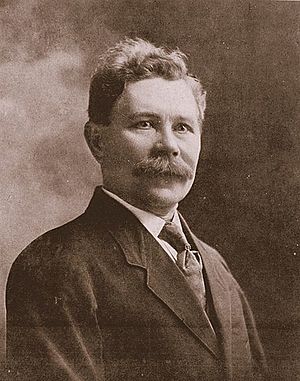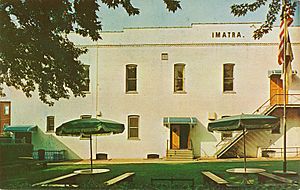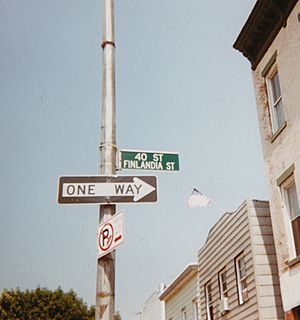Imatra Society facts for kids
The Imatra Society was a group started by Finnish immigrants in Brooklyn, New York. It was founded by John A. Koski, an engineer, with a first meeting on December 6, 1890, and the official founding on December 14, 1890. The main goal of the society was to help Finnish people in America improve their lives and well-being. They also offered help to those in need right from the start.
Contents
Early Days: A Workers' Group
In its early days, the group was called the Workers' Association Imatra. It was the very first workers' group that Finns created in America. Most Finnish immigrants were workers, which is why they chose this name. Even though it was called a "workers' association," it wasn't focused on political ideas like socialism. Instead, it aimed to boost cultural activities for working people and help them get a better education. Women were involved in the group's activities from the beginning. One of their first actions was to start their own brass band. They also formed a singing group and a drama club.
In October 1892, the chairman, John A. Koski, told the group that there was a bad crop harvest in their home country, Finland, and a famine was coming. He said it was their duty to help. Everyone agreed, and they started collecting aid for Finland.
The Imatra Society had a big impact on Finns in America. Other Finnish workers' groups started forming in different places because of it. The Imatra Society began to create a large network of these groups all over North America. In February 1903, the society created the Imatra League. This was a union of Finnish American workers that included about 40 smaller groups across the United States and Canada. Around 2,000 people were members of this league. The workers' groups in the Imatra Union were known by numbers. The original Imatra association in Brooklyn was called Imatra 1.
The Imatra Union eventually broke apart because of new socialist ideas that became popular. People who supported socialism came from Finland and encouraged local workers' groups to leave the Imatra Union and join the American Socialist Party. This split was a big loss for Finnish Americans, as they lost their united cultural community across North America. The league used to publish its own newspaper called Työväen Album (the worker's album). The Imatra League officially ended in February 1917. The Imatra Society (Imatra 1) did not agree with socialism, so it continued its activities as a local Finnish American group on its own.
After leaving the Imatra Union, the socialist groups focused on politics. But later, when Finns became less interested in socialism, these groups also started doing Finnish cultural activities, just like the Imatra Society.
On June 10, 1906, the Imatra Society started its own newspaper, the New Yorkin Uutiset. This newspaper stopped being published in 1992.
In 1906, the Imatra Society had several different parts: a Speaker Club, a Play Club, a Women's Club, a Brass Band, an Entertainment Committee, a Library, and a Reading-room.
In September 1907, the society began collecting money to help farmers in Finland who had lost their homes and farms.
Imatra Hall: A Community Hub
The society built its own building for its activities and moved into it on November 1, 1908. A grand opening celebration was held on November 18 and 19. They even installed a generator to make their own electricity. This was a big deal in the area, which is now called Sunset Park, because the Imatra Society brought the first electric lights to that part of town. This building, later known as Imatra Hall, became the most important place for the society's activities and was very popular among Finnish people.
In December 1908, the society promoted temperance, meaning they encouraged people to avoid alcohol. No alcoholic drinks were allowed in the hall, and no one was allowed to be there if they had been drinking. Smoking was also completely forbidden in the restaurant area.
The Imatra Society also started an employment agency on December 1, 1910. In its first year, the agency helped about 50–60 men and 135 women find jobs. There were many more job openings for women in service roles than there were women looking for those jobs. In 1912, the agency helped people find 242 jobs.
In 1910, the society's theater group performed several plays at Imatra Hall. Some of these included Pimeyden valta (the power of darkness), Charleyn Tähti (the star of Charley), and Tukkijoella (on the log river).
Changing Focus: Aid and National Society
At the society's yearly meeting on January 20, 1918, they made new rules. One rule stated that the society would try its best to make Finnish people well known in the United States. Another rule officially changed the society's name to the Finnish Aid Society Imatra. A special rule also said that if the society ever closed or became too weak, its property could not be sold or moved without special permission from the Senate of Finland. This rule could not be changed.
The society started as a workers' group, then became an aid society, and in July 1921, it was named Kansallisseura Imatra (National Society Imatra).
On May 13, 1923, the Imatra Society sent a group of seven people to Ellis Island to help Finnish immigrants as they arrived in the country.
Special Visitors and Events
Many important visitors from Finland, including artists, came to Imatra Hall. Famous Finnish artists who performed concerts there included Uuno Klami (October 27, 1917), J. Alfred Tanner (May 29, 1924), Robert Kajanus (January 11, 1925), Lea Piltti (April 24, 1949), and Tapio Rautavaara (October 22, 1959).
Other important people who visited Imatra Hall included the famous runner Paavo Nurmi (February 19, 1966), and even the president of Finland, Mauno Koivisto, with his wife, Tellervo Koivisto, and their group on October 25, 1985.
The Imatra Society held a successful festival on December 8, 1935, to celebrate the birthday of the famous composer Sibelius.
For its first 50 years, the society operated as a temperance group, meaning they did not allow alcohol. However, they decided to get a liquor license, and the bar at Imatra Hall started operating on August 27, 1941.
On January 23, 1949, it was announced that the Imatra Society had sent many packages to institutions for poor people and to seven families in Finland. They also planned to continue helping the poor and orphans in Finland.
In 1959, there were discussions about whether non-Finns should be allowed to become members of the Imatra Society. It was finally decided that only Finns would be accepted.
The Imatra Society began to organize Miss Finlandia beauty contests. The first one was held on October 6, 1968. Starting in 1970, Finnair gave the winner a free round-trip flight ticket to Finland.
A group of actors from the National Theater of Finland performed a comedy called Myöhästynyt hääyö (the delayed wedding night) at Imatra Hall on June 2, 1971. It was so popular that they performed it again on June 27.
For its first 95 years, the society's main language was Finnish. But after the annual meeting on February 16, 1986, the language became English. This was because some members did not understand Finnish.
In 1987, the society planned to start an annual music festival at Imatra Hall where Finnish and American artists could perform. They asked music festivals in Finland if they would help organize it, and many responded positively.
On March 7, 1991, a concert was held at Imatra Hall featuring two police choirs: a 60-singer choir from Finland's west coast and a 40-singer choir from the New York City police.
The society's 100th anniversary celebration lasted four days, from September 19–22, 1991. During the celebration, the 40th Street in front of Imatra Hall was also named Finlandia Street. The Finlandia hymn by Sibelius was performed by the Male Singers of Järvenpää from Finland. After this, a parade with flags and traditional costumes led people to Imatra Hall for the main event.
Just a few years after its 100th anniversary, the Imatra Society faced financial problems. By the fall of 1995, it was too deep in debt to recover. Imatra Hall was sold, and the Imatra Foundation was created with the remaining money. The Imatra Society officially closed on April 26, 1996, and the Imatra Foundation ended in the fall of 2011.
Leaders of the Society
| Name of president | Term in office |
|---|---|
| 1. John A. Koski | December 6, 1890 – January 6, 1895
January 25, 1912 – January 29, 1913 |
| 2. Akseli Järnefelt | January 6, 1895 – January 19, 1896 |
| 3. Charles Blomqvist | January 19, 1896 – January 3, 1897 |
| 4. Isak Juselius | January 3, 1897 – January 3, 1899
January 14, 1900 – January 13, 1901 January 12, 1902 – January 14, 1906 January 9 – July 21, 1910 July 23, 1914 – January 10, 1915 January 23, 1916 – January 14, 1917 |
| 5. Esa Takala | January 3, 1899 – January 14, 1900 |
| 6. A. Vilander | January 13, 1901 – January 12, 1902 |
| 7. Eero W. Helin | January 14, 1906 – January 27, 1907
January 10, 1935 – January 9, 1936 February 11, 1937 – January 11, 1942 |
| 8. Salomon Laitinen | January 27, 1907 – January 9, 1910
August 25, 1910 – January 5, 1911 |
| 9. W. Lauri | July 21 – August 25, 1910 |
| 10. Matti Simpanen | January 5, 1911 – January 25, 1912 |
| 11. J. A. Harpet | January 29, 1913 – May 3, 1914
January 10, 1915 – January 23, 1916 |
| 12. A. Uksila | January 14, 1917 – May 5, 1918 |
| 13. Henry Aalto | May 5, 1918 – March 27, 1921
January 26, 1928 – January 9, 1930 |
| 14. Hjalmar Palmrose | March 27, 1921 – January 15, 1922
January 9, 1936 – February 11, 1937 |
| 15. Hjalmar Ketonen | January 15, 1922 – March 18, 1923 |
| 16. Kalle Soini | April 4, 1923 – January 26, 1928 |
| 17. Väinö Jaakkola | January 9, 1930 – January 26, 1931 |
| 18. Karl Lehtinen | January 26, 1931 – September 26, 1932 |
| 19. Gustav Helenius | September 26, 1932 – January 10, 1935 |
| 20. Laila Salo | January 11 – April 19, 1942 |
| 21. A. F. Djerf | April 19, 1942 – January 24, 1943 |
| 22. Väinö Sarlin | January 24, 1943 – January 30, 1944 |
| 23. Elmer Arra | January 30, 1944 – January 19, 1947
June 7, 1949 – January 22, 1950 |
| 24. Hugo Ketola | January 19, 1947 – January 23, 1949
January 18, 1953 – January 22, 1956 January 26, 1964 – January 24, 1965 |
| 25. Risto Rimey | January 23 – June 7, 1949 |
| 26. Werner Wäisänen | January 22, 1950 – January 20, 1952 |
| 27. Maikki Helin | January 20, 1952 – January 18, 1953 |
| 28. Urho Ostman | January 22, 1956 – January 27, 1957 |
| 29. Alan Fillmore | January 27, 1957 – January 26, 1958
January 20, 1963 – January 26, 1964 January 28, 1968 – January 26, 1969 |
| 30. Mauri Pelkonen | January 26, 1958 – January 24, 1960 |
| 31. Eino Salim | January 24, 1960 – January 21, 1962 |
| 32. John Aarnio | January 21, 1962 – January 20, 1963 |
| 33. Harry Manner | January 24, 1965 – January 30, 1966 |
| 34. Alpo Hautamäki | January 30, 1966 – January 28, 1968
January 24, 1971 – January 30, 1972 August 2, 1972 – January 28, 1973 January 27, 1974 – January 26, 1975 January 25 – April 19, 1976 February 14, 1982 – February 6, 1983 |
| 35. Eric Williams | January 26, 1969 – January 25, 1970 |
| 36. Eugen Manner | January 25, 1970 – January 24, 1971 |
| 37. John Ketola | January 30 – August 2, 1972 |
| 38. Arvo Ek | January 28, 1973 – Jan 27, 1974
January 26, 1975 – January 25, 1976 |
| 39. Hjalmar Koivu | April 19, 1976 – January 30, 1977 |
| 40. Urpo Kurko | January 30, 1977 – January 29, 1978 |
| 41. Eino Honka | January 29, 1978 – January 28, 1979 |
| 42. Lempi Issakainen | January 28, 1979 – January 27, 1980 |
| 43. Raymond Anderson | January 27, 1980 – February 14, 1982 |
| 44. Mauno Laurila | February 6, 1983 – March 13, 1988 |
| 45. Veikko Laiho | March 13, 1988 – June 7, 1992 |
Images for kids










